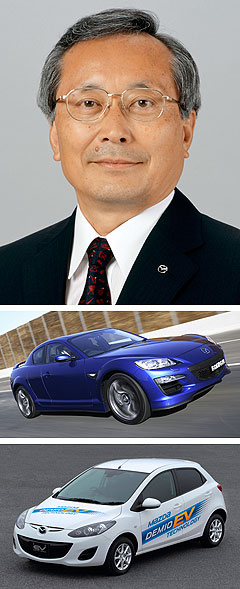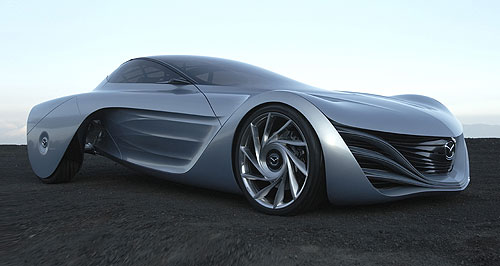Make / Model Search
News - latest articleMazda rotary future assuredRotary future: Mazda’s 2007 Taiki concept featured a development of the company’s rotary engine technology that could make it into production. No RX sports car timing but rotary EV range extender in development for 2013 reveal24 Oct 2012 MAZDA has strongly reiterated that it is working on two separate rotary developments, ensuring the engine’s survival into the next decade. While there is still no firm date of arrival for a much-anticipated return of the Wankel-powered sports car – thought to be based on the next-generation MX-5 coupe and called the RX-7 – the launch of a rotary range extender in an as-yet unannounced electric vehicle from 2013 shows the engine’s greatest long-term potential. The Japanese company is also hoping to sell the technology to other manufacturers wanting a compact, smooth, and economical powerplant for any combination of EV and hybrid applications, stressing that a rotary at a constant 2000rpm and not under load is at its most frugal. Speaking to journalists on the eve of the Australian International Motor Show in Sydney last week, Mazda CEO Takashi Yamanouchi declared his ongoing support for the engine that almost buried Mazda after the first oil crisis of 1973. He also hinted that the disadvantages of high consumption and low torque might be a thing of the past in the case of the next RX. “With the demise of the RX-8 earlier this year, I want to tell you that we are continuing with rotary engine development,” he said.  From top: Mazda CEO Takashi Yamanouchi Mazda RX-8 Mazda2 EV. From top: Mazda CEO Takashi Yamanouchi Mazda RX-8 Mazda2 EV.“I think there are two ways where the rotary can be used in the future. One: use the rotary engine to power the vehicle itself as before. “But in order to realise that, we need to further improve the fuel economy and low-end torque. Right now we are working on a rotary engine with a bigger diameter and bigger displacement of the concentric chamber. “The second approach for using the rotary engine is to capitalise on the engine’s ability to run smoothly at a constant speed… by using it as a range extender in a hybrid vehicle. “With EVs the cost and the range are the biggest obstacles and in terms of overcoming the range issue, using the rotary is a very effective approach. “From this month we have started marketing an electric vehicle in Japan from next year we will also market in Japan an EV with a range extender with a rotary engine incorporated.” The EV in question is a production run of 100 Mazda2 (called Demio in Japan) light cars fitted with a 346-Volt, 20kWh lithium-ion battery module for a 200km range, only available in Japan on a lease basis. However Mr Yamanouchi would not be drawn on revealing which model will get the rotary range-extender system next year. “It is a secret – you will have to just wait and see”, he said. Mr Yamanouchi is also hopeful other manufacturers will open their minds to the rotary’s potential in EVs. “We consider this engine to have potential in Mazda’s future… we still consider it to be iconic… so we will continue to work on it,” he stated. “I think there will be other manufacturers who might be interested. “Right now we have to be doing it by ourselves, but in the future as others recognise the advantages of the technology, I am sure others might be interested.” Far from being a dead-end development, Mr Yamanouchi believes the rotary as a range extender will be one of the keys to Mazda’s survival in the long term. “We will be looking forward to introducing this product in Japan…,” he said. “And maybe in the future when EVs become more popular, we like to ensure we have the right car. “If you are running the rotary at a constant 2000rpm it is providing very good fuel economy plus low vibration, and it also has the advantage of being compact… so it has a high potential as a range extender.” Mazda showcased an experimental ‘16X Renesis 2’ rotary engine in the Taiki concept it unveiled at the 2007 Tokyo motor show as part of a celebration of its 40 years working with rotaries. At the time, Mazda talked about the rotary gaining higher thermal efficiency, greater torque across more engine speeds, direct-injection technology, greater displacement, and decreased weight through the use of an aluminium housing. A Mazda veteran of 45 years, Mr Yamanouchi has long championed the rotary engine, declaring on record that the rotary will always have a future as long as he works for the company. “We have not given up on the rotary sports car,” he reiterated in Sydney. Despite Mr Yamanouchi’s enthusiasm, Audi recently announced it will not pursue the rotary range extender path with the next phase of its A1 e-tron trial, instead using a new 1.5-litre three-cylinder unit providing significantly more power. The first-generation A1 e-tron prototypes employed a rear-mounted 15kW 254cc rotary range-extender engine not supplied by Mazda as the long-dormant NSU company Audi merged with in 1969 pioneered rotary development.  Read more |
Click to shareNews categoriesMotor industry news |












Facebook Twitter Instagram